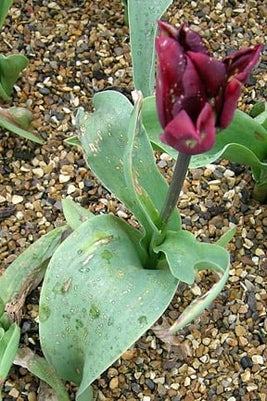
Quick facts
Common name - Tulip fire
Scientific name - Botrytis tulipae
Plants affected - Tulipa spp. (tulips)
Main symptoms - Brown spots, distorted and twisted leaves, fuzzy grey mould
Caused by - Fungus
Timing - Late winter until summer
What is tulip fire?
Tulip fire is caused by the fungus Botrytis tulipae. It is closely related to the grey mould pathogen, Botrytis cinerea. Leaf symptoms are visible from when leaves emerge in late winter until they die back in summer.
The disease is only a significant problem on tulips , although it has occasionally been found on lilies. It tends to be more damaging if there is prolonged wet weather in spring, providing ideal conditions for the fungus to spread from plant to plant via airborne spores.
Symptoms
You may see the following symptoms:
- Distorted or twisted leaves appear soon after emergence from the soil and may wither or fail to develop
- Brown spots of dead tissue on leaves. In severe cases the spots enlarge and extensive areas become brown and withered, giving the impression of fire scorch
- A fuzzy grey mould may grow over the dead areas in damp conditions
- Spots on flowers and, in wet weather, the petals rot rapidly
- Small black seed-like structures (sclerotia) are produced on the dead tissue and can contaminate the soil, and also the outer bulb scales
Tulips are also sometimes affected by grey bulb rot, caused by another fungus called Rhizoctonia solani. This causes similar symptoms to tulip fire. Usually infected with Rhizoctonia solani fail to emerge, but if they do, the growth may be distorted in a similar way to tulip fire. However, they won’t show the fuzzy grey fungal growth.
Control
Non-chemical control
- Check carefully and discard any with signs of the small black sclerotia in the outer scales, or with any signs of decay
- Remove infected bulbs promptly to avoid contaminating the soil with sclerotia
- Do not plant tulips for at least three years in sites where tulip fire has occurred (five years if the disease is grey bulb rot)
- If a contaminated site must be replanted, dig the ground deeply to try and bury the contaminated upper layers deep enough to be below planting depth
- Space bulbs adequately and plant them in areas with good air circulation. Very dense planting of tulips, or growing them in places where the air circulation is poor (e.g. close to fences or where other planting is crowded) will result in the humid conditions the fungus likes and make it easier for the airborne spores to spread from plant to plant
Chemical control
There are no chemical controls available to home gardeners for use against tulip fire.
Biology
Botrytis tulipae is closely related to the grey mould pathogen Botrytis cinerea. B. cinerea has a very wide host range, but B. tulipae is one of a number of species which are much more host specific. It is only a significant problem on tulips, but has also been found occasionally on lilies.
This fungus spreads in two ways:
- Small black seed-like structures (sclerotia) are produced in dead tissue. These can contaminate the soil for several years and also remain in the outer bulb scales. When the produce new growth in spring, the leaves may therefore be infected either from the sclerotia in the scales, or those in the soil.
- The fungus also produces airborne spores from the fuzzy growth of grey mould.



